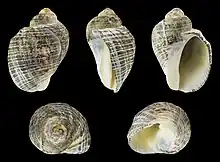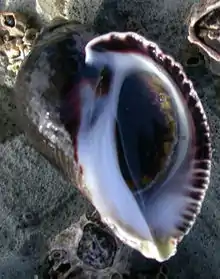Haustrum haustorium
Haustrum haustorium, common name: the brown or dark rock shell, is a large species of predatory sea snail, a marine gastropod mollusc in the family Muricidae, the murex snails or rock snails.
| Haustrum haustorium | |
|---|---|
 | |
| Scientific classification | |
| Domain: | Eukaryota |
| Kingdom: | Animalia |
| Phylum: | Mollusca |
| Class: | Gastropoda |
| Subclass: | Caenogastropoda |
| Order: | Neogastropoda |
| Family: | Muricidae |
| Genus: | Haustrum |
| Species: | H. haustorium |
| Binomial name | |
| Haustrum haustorium (Gmelin, 1791) | |
Taxonomy
Haustrum haustorium used to be the only species in the genus Haustrum. However, Beu (2004) reclassified a number of New Zealand's whelks, considering species in the genus Lepsiella to be synonymous with the genus Haustrum.
Distribution
This species occurs in New Zealand.
Shell description

A reliable characteristic for distinguishing Haustum haustorium from its congeners is the angle by which the aperture lip inserts on the shell: In Haustrum haustorium the angle is near-perpendicular, whereas in other species the angle is more acute (~45 degrees). Tan (2003) provides the most recent review.
Ecology
Habitat
This rock snail's typical habitat is the mid and lower eulittoral zone of New Zealand's semi-exposed rocky intertidal shores. It is less common on algal-dominated sheltered shores.
References
- Powell A W B, New Zealand Mollusca, William Collins Publishers Ltd, Auckland, New Zealand 1979 ISBN 0-00-216906-1
- Beu, A. G. 1990. Molluscan generic diversity of New Zealand Neogene stages: extinction and biostratigraphic events. - Palaeogeography, Palaeoclimatology, Palaeoecology 77: 279-288.
- Glen Pownall, New Zealand Shells and Shellfish, Seven Seas Publishing Pty Ltd, Wellington, New Zealand 1979 ISBN 0-85467-054-8
- Miller M & Batt G, Reef and Beach Life of New Zealand, William Collins (New Zealand) Ltd, Auckland, New Zealand 1973
- Tan, K. S. 2003. "Phylogenetic analysis and taxonomy of some southern Australian and New Zealand Muricidae (Mollusca: Neogastropoda)". Journal of Natural History 37: 911–1028.